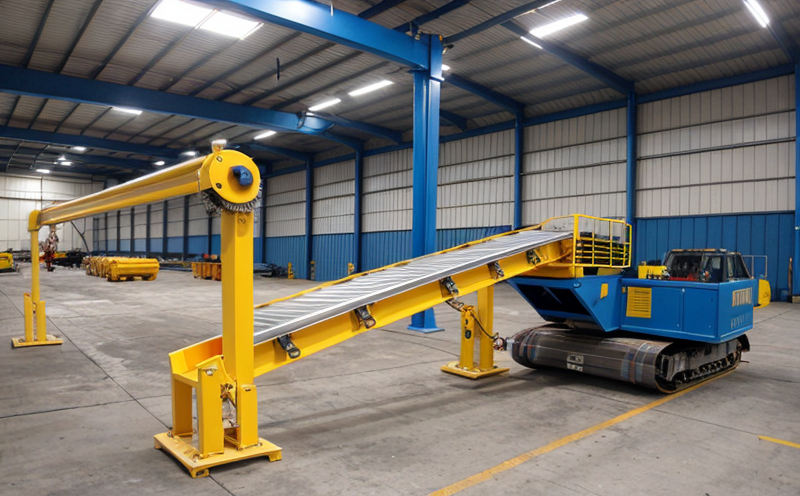EN 14492 Winches and Hoists Performance Testing
The European standard EN 14492 specifies the performance testing requirements for winches and hoists used in various industrial settings, including mining. This service ensures that these critical pieces of equipment meet stringent safety and operational performance criteria, which is essential for maintaining compliance with international regulations.
Winches and hoists are indispensable components in many industries due to their ability to efficiently lift heavy loads. In the mining sector, they play a crucial role in transporting materials within underground mines or at surface facilities. The robustness of these devices directly impacts productivity, safety, and overall operational efficiency. Therefore, ensuring that winches and hoists meet EN 14492 standards is imperative for both new equipment procurement and routine maintenance.
The testing process under EN 14492 involves several key stages designed to evaluate different aspects of the device's performance. These include static load tests, dynamic load tests, speed tests, and durability assessments. Each stage aims to uncover potential weaknesses or areas requiring improvement before the equipment is put into use.
Static load testing determines whether a winch or hoist can withstand its rated capacity without failure. Dynamic load testing simulates real-world operating conditions by applying cyclical loads over time to assess fatigue resistance. Speed tests ensure that the device operates within specified parameters, while durability assessments examine how well it performs under continuous use.
Specimen preparation is a critical step in EN 14492 compliance testing. Specimens must be prepared according to specific guidelines outlined by the standard to ensure accurate results. This includes cleaning the specimen thoroughly, marking key areas for observation during testing, and applying any necessary coatings or treatments before placing it on the test rig.
Instrumentation plays a vital role in collecting precise data throughout the testing process. Sophisticated sensors measure various parameters such as force applied, displacement rate, temperature changes, noise levels, and electrical current draw. This information is crucial for evaluating not only individual performance metrics but also identifying potential areas for improvement based on real-world usage scenarios.
The results from EN 14492 testing are typically reported in detailed technical documents that provide comprehensive insights into the tested equipment's capabilities. These reports serve multiple purposes, including supporting procurement decisions by offering independent verification of product quality, guiding maintenance schedules through early detection of wear patterns or other issues, and enhancing safety standards across all operations.
Compliance with EN 14492 not only ensures adherence to international standards but also demonstrates a commitment to operational excellence within the mining industry. By investing in comprehensive performance testing services based on this standard, organizations can enhance their reputation among peers while simultaneously safeguarding against costly downtime or accidents resulting from substandard equipment.
Our expertise lies in delivering accurate and reliable EN 14492 compliance testing tailored specifically to your organization’s unique needs. With a deep understanding of both the standards themselves as well as practical applications within the mining sector, we offer robust support throughout every aspect of the testing process—from initial consultation through final report delivery.
For more information about how our EN 14492 winches and hoists performance testing service can benefit your organization, please contact us today. We look forward to helping you achieve peak operational efficiency while maintaining industry-leading safety standards.
Applied Standards
In addition to EN 14492, other relevant international standards include ISO 9001 for quality management systems and OSHA regulations governing workplace safety. Compliance with these standards ensures that all aspects of our testing process are conducted in a manner consistent with best practices recognized worldwide.
ISO 9001 focuses on continuous improvement processes designed to enhance overall customer satisfaction by ensuring consistent delivery of high-quality products and services. By adhering to this standard, we maintain rigorous controls over every stage of the testing lifecycle—from project initiation through completion.
The Occupational Safety and Health Administration (OSHA) provides comprehensive guidelines aimed at protecting workers from hazards associated with handling heavy loads or operating complex machinery like winches and hoists. Adherence to these regulations helps mitigate risks during both manufacturing and operational phases, ensuring safer working environments for everyone involved.
Customer Impact and Satisfaction
By implementing EN 14492 compliant testing procedures, customers experience several tangible benefits:
- Improved Safety: Ensures that all equipment meets the highest safety standards set forth by international authorities.
- Enhanced Reliability: Identifies potential weaknesses early in development cycles so they can be addressed before going live.
- Better Decision Making: Provides objective data to inform procurement choices and guide investment strategies.
- Increased Efficiency: Helps identify bottlenecks or inefficiencies that could otherwise lead to lost production time.
Our commitment to excellence extends beyond simply meeting regulatory requirements; we strive to exceed expectations by delivering thorough, transparent reports accompanied by actionable recommendations based on empirical evidence gathered during testing. This approach fosters long-term partnerships built upon trust and mutual respect for shared goals.
Competitive Advantage and Market Impact
Adopting EN 14492 compliant practices offers numerous strategic advantages that can help organizations gain a competitive edge:
- Innovation Leadership: By staying ahead of emerging trends in safety and performance, companies positioned themselves as leaders within their respective markets.
- Better Brand Reputation: Demonstrating adherence to rigorous international standards enhances brand perception among stakeholders, including investors, customers, and regulatory bodies.
- Premium Pricing Power: Premium pricing strategies become feasible when backed by verifiable compliance certifications like those provided through EN 14492 testing services.
- Diversified Client Base: Meeting specific industry requirements opens doors to new business opportunities across diverse sectors where similar standards apply.
In today’s competitive marketplace, maintaining a strong reputation for reliability and safety is more important than ever. Our comprehensive EN 14492 compliance testing services play an integral role in helping organizations achieve these objectives, thereby fostering sustained growth and success.





